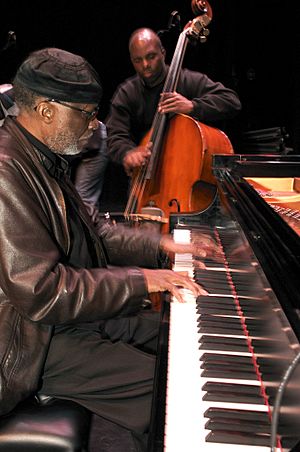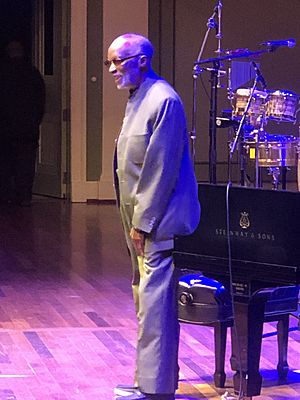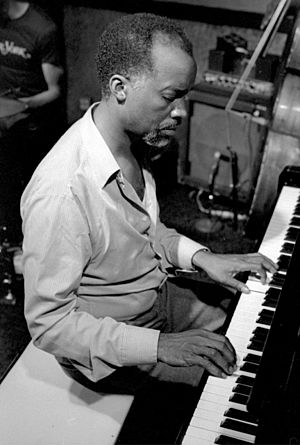Ahmad Jamal facts for kids
Quick facts for kids
Ahmad Jamal
|
|
|---|---|

Jamal performing with bassist James Cammack in 2007
|
|
| Background information | |
| Birth name | Frederick Russell Jones |
| Born | July 2, 1930 Pittsburgh, Pennsylvania, U.S. |
| Died | April 16, 2023 (aged 92) Ashley Falls, Massachusetts, U.S. |
| Genres |
|
| Occupation(s) | Musician |
| Instruments | Piano |
| Labels | |
Ahmad Jamal (born Frederick Russell Jones, July 2, 1930 – April 16, 2023) was an American jazz pianist, composer, bandleader, and teacher. For over 60 years, he was one of the most successful leaders of small jazz groups. He was honored as an NEA Jazz Master and received a Lifetime Achievement Grammy for his amazing contributions to music.
Contents
Biography
Early life
Ahmad Jamal was born Frederick Russell Jones in Pittsburgh, Pennsylvania, on July 2, 1930. He started playing the piano when he was just three years old! His uncle challenged him to copy what he was playing, and that's how it began. Jamal started formal piano lessons at age seven with Mary Cardwell Dawson, who he said taught him a lot.
Pittsburgh was very important to him. He grew up surrounded by the music of jazz artists like Earl Hines and Mary Lou Williams. Jamal also studied with pianist James Miller. By age fourteen, he was already playing piano professionally. The famous pianist Art Tatum even called him a "coming great." Jamal once said he always thought about music, even when he wasn't practicing.
Beginnings
After finishing high school in 1948, Jamal started touring with George Hudson's Orchestra. He later moved to Chicago in 1950 and played with local musicians.
Jamal grew up in a Christian family, but he became interested in Islam when he was a teenager. He learned about Islam while touring in Detroit, where there was a large Muslim community. In 1950, he converted to Islam and changed his name to Ahmad Jamal. He told The New York Times that he wanted to "re-establish my original name." He also said he prayed five times a day in Arabic, following Muslim traditions.
Jamal made his first recordings in 1951 with a group called The Three Strings. This group later became known as the Ahmad Jamal Trio. The other members were guitarist Ray Crawford and different bass players, including Israel Crosby. The Three Strings became famous after playing at the Embers in New York City. There, a record producer named John H. Hammond saw them play and signed them to Okeh Records. Hammond had helped many famous musicians like Benny Goodman and Billie Holiday. He also helped Jamal's trio become well-known. Jamal then recorded for other labels like Parrot and Epic.
At the Pershing: But Not For Me

The trio's sound changed when drummer Vernel Fournier joined in 1957. The group became the "House Trio" at Chicago's Pershing Hotel. They released a live album called At the Pershing: But Not for Me. This album was a huge hit and stayed on the Ten Best-selling charts for 108 weeks! Jamal's famous recording of the song "Poinciana" was first released on this album.
At the Pershing was recorded in 1958. It made Jamal very popular in the late 1950s and 1960s. Jamal played with bassist Israel Crosby and drummer Vernel Fournier. The album included many different songs, like "The Surrey with the Fringe on Top" from the musical Oklahoma! and Jamal's version of "Poinciana."
Jazz musicians and fans loved At the Pershing. Jamal's trio was seen as a new and important part of jazz history. He used a unique style, which was sometimes called "minimalist." This meant he used a lot of "space" in his music, letting notes and sounds breathe. He also used extended vamps, which are repeated musical phrases. One reviewer said that Jamal's music showed how enjoyable mainstream art could also be very new and different.
After the success of But Not For Me, Jamal's music became even more popular. He even started investing his earnings. In 1959, he toured North Africa to explore business ideas. Jamal, who was 29, was curious about the homeland of his ancestors, especially after converting to Islam. He felt his religion brought him peace and helped his music career. When he returned to the U.S., the money from Live at the Pershing allowed him to open a restaurant and club in Chicago called The Alhambra. In 1962, The Three Strings broke up, and Jamal moved to New York City. He took a break from music for a while.
Return to music and The Awakening
In 1964, Jamal started touring and recording again. He played with bassist Jamil Nasser and released a new album, Extensions, in 1965. Jamal and Nasser played together until 1972. He also played with drummer Frank Gant for many years. Until 1970, he only played acoustic piano. His album The Awakening was one of his last on acoustic piano. In the 1970s, he also started playing electric piano. He continued to perform throughout the 1970s and 1980s, mostly in trios. He often played for New Year's Eve celebrations at Blues Alley in Washington, D.C..
Later career
Even in his 80s, Jamal continued to tour and record. He released albums like Saturday Morning (2013) and Marseille (2017). He was also a main mentor to the talented jazz pianist Hiromi Uehara.
Death
Ahmad Jamal passed away on April 16, 2023, at his home in Ashley Falls, Massachusetts. He was 92 years old.
Style and influence
"Ahmad Jamal is one of the great Zen masters of jazz piano. He plays just what is needed and nothing more... every phrase is perfect."
Jamal was trained in both traditional jazz (which he called "American classical music") and European classical music. He was known as one of the greatest jazz innovators throughout his long career. After the fast-paced bebop style of musicians like Charlie Parker, Jamal helped create a new jazz movement. This style was later called "cool jazz" and aimed to make jazz more like popular music. He focused on using "space" and "time" in his music, rather than just playing very fast.
Because of this unique style, some jazz writers didn't take Jamal seriously at first. However, others, like author Stanley Crouch, said Jamal was a true innovator. Crouch even said Jamal was second in importance only to Charlie Parker in jazz after 1945. Jamal's special musical style came from his use of orchestral effects and his ability to control the beat of songs. He created a new sound for the piano trio. He used space and changed rhythms and tempos to make his group sound like a big band. Jamal focused on the texture of riffs, timbres, and musical phrases, instead of just playing many notes quickly.
A. B. Spellman of the National Endowment for the Arts said that "Nobody except Thelonious Monk used space better." Jamal's new techniques, which he learned from both classical and jazz music, helped inspire later jazz greats like Bill Evans and Herbie Hancock.
Even though some jazz critics sometimes overlooked Jamal, he greatly influenced Miles Davis. Davis said he was impressed by Jamal's rhythm, his "concept of space," and his light touch. Jamal and Davis became friends in the 1950s. Davis continued to play versions of Jamal's songs, like "Ahmad's Blues," until he passed away in 1991.
Jamal himself said, "I like doing ballads. They're hard to play. It takes years of living, really, to read them properly." He learned to appreciate the words of songs from a young age. He said his style developed from growing up in different musical eras: the big band era, the bebop years, and the electronic age. In 1985, Jamal did an interview and recording session with fellow jazz pianist Marian McPartland on her NPR show Piano Jazz. He rarely played "But Not For Me" because it was so popular. He mentioned that he started making 90% of his music his own compositions.
In his later years, Jamal welcomed electronic influences in jazz. He also sometimes added a tenor saxophone or a violin to his usual trio. A jazz fan described his later playing as "more aggressive and improvisational."
Saxophonist Ted Nash described playing with Jamal. He said Jamal didn't just fill space with chords. Instead, he would play single notes and respond directly to what Nash played. This made Nash stop and think, and then feel like playing something new.
Jamal recorded with the Howard A. Roberts Chorale, vibraphonist Gary Burton, and the Assai Quartet. He also celebrated his hometown of Pittsburgh with brass, reeds, and strings. He recorded with saxophonist George Coleman on the album The Essence.
Awards and honors
- 1959: Entertainment Award, Pittsburgh Junior Chamber of Commerce
- 1980: Distinguished Service Award, City of Washington D.C., Anacostia Neighborhood Museum, Smithsonian Institution
- 1981: Nomination, Best R&B Instrumental Performance ("You're Welcome", "Stop on By"), NARAS
- 1986: Mellon Jazz Festival Salutes Ahmad Jamal, Pittsburgh, Pennsylvania
- 1987: Honorary Membership, Philippines Jazz Foundation
- 1994: American Jazz Masters award, National Endowment for the Arts
- 2001: Arts & Culture Recognition Award, National Coalition of 100 Black Women
- 2001: Kelly-Strayhorn Gallery of Stars, for Achievements as Pianist and Composer, East Liberty Quarter Chamber of Commerce
- 2003: American Jazz Hall of Fame, New Jersey Jazz Society
- 2003: Gold Medallion, Steinway & Sons 150 Years Celebration (1853–2003)
- 2007: Living Jazz Legend, Kennedy Center for the Performing Arts
- 2007: Ordre des Arts et des Lettres, French government
- 2011: Down Beat Hall of Fame, 76th Readers Poll
- 2015: Honorary Doctorate of Music, The New England Conservatory
- 2017: Grammy Lifetime Achievement Award, The Recording Academy
- 2018: Leopolis Jazz Music Awards Leopolis Jazz Fest, Lviv
Discography
Here are some of Ahmad Jamal's albums:
| Year recorded | Title | Label | Notes |
|---|---|---|---|
| 1951–55 | The Piano Scene of Ahmad Jamal | Epic | Trio, with Ray Crawford (guitar), Eddie Calhoun and Israel Crosby (bass) |
| 1958 | At the Pershing: But Not for Me | Argo | Trio, with Israel Crosby (bass), Vernel Fournier (drums); recorded live |
| 1960 | Happy Moods | Argo | Trio, with Israel Crosby (bass), Vernel Fournier (drums) |
| 1970 | The Awakening | Impulse! | Trio, with Jamil Nasser (bass), Frank Gant (drums) |
| 1985 | Digital Works | Atlantic | Quartet, with Larry Ball (bass), Herlin Riley (drums), Iraj Lashkary (percussion) |
| 2013 | Saturday Morning: La Buissonne Studio Sessions | Jazz Village | With Reginald Veal (bass), Herlin Riley (drums), Manolo Badrena (percussion) |
| 2016 | Marseille | Jazz Village | Most tracks quartet, with James Cammack (bass), Herlin Riley (drums), Manolo Badrena (percussion) |
| 2019 | Ballades | Jazz Village | Mostly solo piano; some tracks with James Cammack (bass) |
See also
 In Spanish: Ahmad Jamal para niños
In Spanish: Ahmad Jamal para niños



